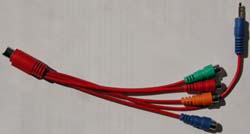ATI All-in-Wonder 9700 Pro Preview
by Matthew Witheiler on September 30, 2002 6:30 AM EST- Posted in
- GPUs
Some hardware was also added to the R300 chip to allow for component video output with no external conversion circuitry. This means that the dip-switched DVI dongle that was necessary for the All-in-Wonder 8500DV is a thing of the past. Now component output supporting 480i, 480p, 720p, and 1080i is available with the use of a simple cable dongle. Simply plug the dongle into the output port on the back of the All-in-Wonder 9700 Pro and you are set.
Since the dongle is now simply made of cables, ATI is able to package it along with every All-in-Wonder 9700 Pro. This should all but secure the card's success in the home theater market, where component input is a must and the options available are limited at best. ATI also assured us that the overscan issues we encountered in our last test of the All-in-Wonder's component video support are fixed this time around.

The final role that the R300 chip plays in the All-in-Wonder 9700 Pro's multimedia capabilities will not fully be taken advantage of for some months now. Thanks to the R300's fully programmable pixel pipeline, the All-in-Wonder 9700 Pro has the ability to run pixel shaders on incoming video. This means that professional video effects that used to require expensive hardware and post video processing can now be done in real time on the chip. We got to see a bunch of demonstrations where live video input from a camcorder was being modified by pixel shaders to do everything from edge detect (resulted in only outlines of the shapes in the scene) to a hall of mirrors effect (contorted the video like a house of mirrors would). The ability to pass video through the pixel shaders is very exciting, as it allows for any number of effects to occur in real time on video. The only problem is that software support for this feature is not quite there yet.
In order to run pixel shaders on video, the video has to be inserted into the 3D pipeline. As it stands now, video bypasses the 3D pipeline all together therefore making it impossible to run pixel shaders on live video for display. This is set to change with Microsoft's release of DirectX 9, as the new API allows video to be passed through the 3D pipeline (thanks to the VMR 9 specifications). Because DirectX 9 is not out yet, it is not currently possible to pass pixel shaders over inputed video without the use of beta software. For example, the system we saw the effects performed on was running a beta version of DirectX 9 and software written by ATI to enable the video processing. Once DirectX 9 comes out, however, look for video software packages that support pixel shaders to start popping up.










0 Comments
View All Comments